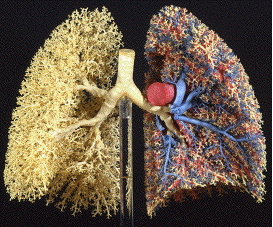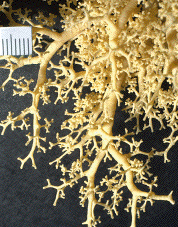|
Pictures of lung casts, two with circulatory system casts included. Casts and pictures by Dr. Ewald R. Weibel. |
| For exxective exchange of O2 and CO2, our lungs must compress
a large surface area into a small volume. While the volume of our lungs is only about 5 or 6
liters, the surface area is about 130 meters2. (How
do we know the area?) For a sense of comparison, the surface ara of our
skin is about 3 meters2. Weibel points fitting the lung area into the chest cavity
is about the same as folding an envelope to fit in a thimble. |
| Ant it isn't just any folding: during exercise, we need to be able to get
air in and out of all of the lungs in about a second. Our lungs achieve this by having
no part of the lung more than about 20 cm from the trachea. |
| Lungs branch between 18 and 30 times, with the average being 23 times. |
| The first 15 levels of branching constitute the conducting airway. Throughout the
conducting airway, at each branching the daughter branches have diameters about
2-1/3 that of their mother. This ratio minimizes turbulence,
easing the task of getting air in and out of the lungs. |
| The remaining branches are the exchange zone. Attached to these branches are the
alveoli, tiny chambers, about 1/4 mm in diameter, where the exchange of
O2 and CO2 occurs. We have about 500,000,000 alveoli. |
| Weibel, and others, believe that specific details of lung structure are not
hard-wired into our DNA. Rather, our DNA encodes growing instructions. |
| Viewed in this way, and despite appearances, our lungs are rather simple
structures. |
|


